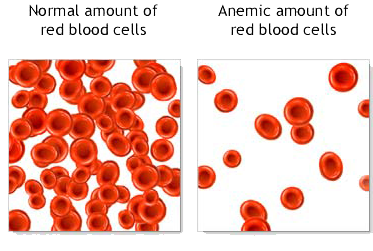Anemia




Anemia is a common symptom following surgery and with ADPKD.
PKD Anemia
As kidney cells become damaged from cysts, the cells that create erythropoietin also become damaged. Erythropoietin stimulates red blood cell production. Anemia can come about from this lack of erythropoietin but also from red blood cells that become destroyed. This destruction leads to a reduced number of red blood cells or a reduced number of cells to carry oxygen.Itchy Skin & Anemia
If you have kidney cysts this 2016 medical article has found an association between itching, eosinophilia and anemia. Get your anemia checked and have it corrected. With liver cysts, itching is thought to be related to elevated bilirubin. With itching, in addition to bilirubin, ask for a hemoglobin and hematocrit to check for any anemia.
Anemia comes about when the blood lacks oxygen carrying power either from too little blood cells or the red blood cells present have too little hemoglobin to carry the oxygen or red blood cells are simply destroyed. With PKD all of this takes place simultaneously. There is a need to correct this quickly.
Foods to Help Anemia
Broccoli
Cereal Grass Juice
Cruciferous Vegetables
Grapes
Green Juice
Green Juice more
Kale
Leafy Greens
Radish
Raisin
| Iron in Plant Based Foods | ||
| Food | Preparation | Serving |
| Broccoli | chopped, boiled ½ C | 0.52 |
| Spinach | chopped, boiled ½ C | 3.2 |
| Kale | chopped, boiled ½ C | 0.59 |
| Collard greens | chopped, boiled ½ C | 1.1 |
| Swiss chard | chopped, boiled ½ C | 2 |
| Sweet potato | baked with skin ½ C | 0.7 |
| Oatmeal | cooked ½ C | 1 |
| Kidney beans | boiled ½ C | 1.8 |
| Pinto beans | boiled ½ C | 2 |
| Garbanzo beans | boiled ½ C | 2.4 |
| Peas green | boiled ½ C | 1.2 |
| Lentils | boiled ½ C | 3.3 |
| Hummus | 2 T | 0.7 |
| Tahini | 2 T | 0.7 - 2.6 |
| Walnuts | chopped ¼ C | 0.85 |
| Almonds | roasted ¼ C | 1.3 |
| Dried Figs | boiled ½ C | 1.5 |
| Raisins | ½ C | 1.4 |
Harm in Prolonged Anemia
Anemia can cause our hearts to pump harder to get lower oxygenated blood circulated throughout the body. This harder pumping action can lead to LVH, left ventricular hypertrophy. The heart tries to deliver this low oxygen blood to our cells. An accumulation of exhausts like carbon dioxide, relaxes blood vessels and lowers diastolic blood pressure. Fatigue sets in from a lack of adequate oxygen at the tissue level, and a build up of acids within cells forms as they must shift toward anaerobic or oxygen-free processes. These are short-lived mechanisms. Eventually these oxygen free processes produce a great deal of acid build up in the cellular tissues.
There was a study done on the post mortem autopsy reports of 10,000 individuals who died following surgery to clear their blood vessels of clots. Most of the people who died had not re-clotted their blood vessels. The blood vessels remained open. The heart muscle itself, the left ventricle was in a state of oxygen loss; it was in acidosis. The clearing of acids had become too great for the body and it was unable to recover.
The number one cause of death of individuals with polycystic kidney disease is left ventricular hypertrophy LVH, or enlargement of the ventricle muscle of the heart. This portion of the heart muscle has to work to pump blood throughout the body quickly attempting to rush it to the organs so it can be rapidly changed to alkaline. This is intensified by an anemia. By maintaining an internal alkalinity, this assists the body especially the liver, kidneys and heart.
According to the below articles: "Left Ventricular Hypertrophy LVH was diagnosed in 56% patients. Incidence of LVH was directly related to the severity of anemia (p = 0.017) This was a 2007 study on the incidence of left ventricular hypertrophy (LVH) during the predialysis stage of chronic kidney disease and after kidney transplant. Following kidney transplant LVH incidence was lower. Also after transplant proteinuria was less and creatinine of course was improved."
"The presence of high blood pressure in PKD appear to be related to renal failure and LVH (enlarged heart). Patients with LVH had a worse renal survival."
"CONCLUSION: A prolonged course of ACE-inhibitor therapy is effective in regressing the persistent LVH of renal transplant recipients by mechanisms independent of effects on BP. This regression seems to be at least in part the effect of an interaction between ACE inhibitors and cyclosporine."
"Left ventricular hypertrophy, a major cardiovascular risk factor, was decreased to a significantly greater extent by rigorous BP control. This finding has particular clinical importance because cardiovascular complications are the most common cause of death in ADPKD patients."
